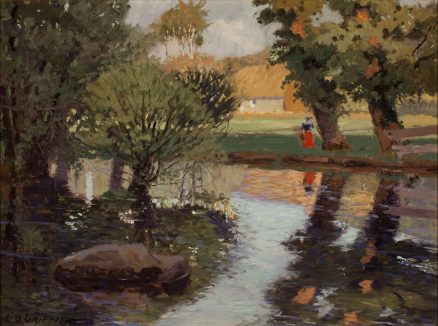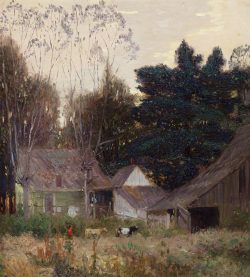- Categories
- Landscapes
- Zoom in on Artwork
- Print Page
- Email Page to Friend
L. O. Griffith painted The River Aven in Brittany, a picturesque region in northwestern France. The rippling water of a shallow stream fills the shadowed foreground; in the distance, late-afternoon sunlight highlights the blocky form of a building beyond an open field. The complex composition layers screening shrubs and trees and features strong contrasts of light and color; these are accentuated in the forms’ broken reflections on the water’s surface, interrupted by a large rock at the lower left and by the dense foliage of trees sprouting from tussocks in midstream. As in Griffith’s Untitled (Late Afternoon on the Farm), an isolated stroke of red—here the skirt of a woman on the riverbank—creates a focus in the scene. Apparently one of two overlapped figures, the woman wears what may be the prominent white starched lace collar and white cap of traditional Breton dress.
Griffith’s only trip abroad took him to France and England in 1908. The Aven flows through the town of Pont-Aven, which drew French and American artists beginning in the mid-nineteenth century. Americans in particular were attracted to the quaint settings and way of life they found in rural and coastal villages in Holland and northern France and to the peculiar light conditions of the region. In this work, Griffith balanced the formal aspects of landscape composition with references to the specific setting, such as the figure’s distinctive costume and the building, likely a typical Breton longère, or one-story house with stone walls and a thatched roof. With its bright color and contrasts of light and dark, this painting prefigured Griffith’s characteristic portrayal of Brown County, Indiana, in the following years. Exhibited in the Art Institute of Chicago’s thirteenth annual exhibition for Chicago artists, The River Aven was reproduced in the Chicago Journal for February 2, 1909.
During his time abroad, Griffith not only painted landscapes but also worked to perfect his technique in color intaglio printmaking. That experience may well have influenced his painting, encouraging him to abandon the drawing-based academic approach seen in the more naturalistic Untitled (Late Afternoon on the Farm) as he experimented with composing in broad sweeps of color and contrasting areas of light and shade.
Wendy Greenhouse, PhD
Donated by M. Christine Schwartz to the Indiana State Museum, Indianapolis, Indiana, in 2021

